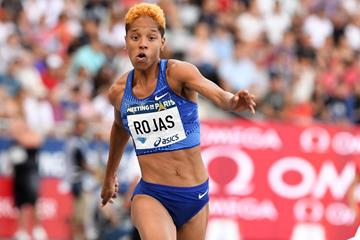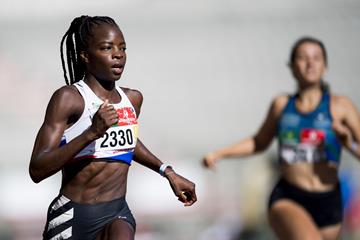 Countdown
Countdown
 Countdown
Countdown
The triple jump is one of the two horizontal jump events on the track and field programme.
During the triple jump, each competitor must run down the track and perform a hop, a step and then a jump into a sand pit. The distance travelled, from the edge of a wooden take-off board to the closest indentation in the sand, is then measured.
The origin of triple jump can be traced back to the 15-metre jumps at the ancient Olympic Games
The triple jump consisted of two hops and one jump at the inaugural modern Olympics in 1896
The current format of hop, step and jump was standardised in 1908
The men’s triple jump has been contested at every modern Olympic Games
The first women’s triple jump competition at Olympics was held in 1996.
Triple jump is a sport that requires a combination of speed, explosive power, strength and flexibility.
The women’s triple jump has grown in popularity in recent years. This started in 1990, when World Athletics ratified the first women’s triple jump records. Unofficial records date back to 1922, when the first unofficial women’s triple jump world record was set by Elizabeth Stine (10.32m).
Li Huirong of China was the first female athlete to set an official triple jump record. She jumped 14.54m at a meet in Sapporo, Japan, in 1990. Not long after, Russian athlete Anna Biryukova jumped 15.09m at the 1993 World Athletics Championships. This made her the first female to surpass the 15-metre mark.
The current women’s triple jump world record-holder is Yulimar Rojas of Venezuela. She made history by jumping 15.74m at the 2022 World Athletics Indoor Championships.
While the official history of women’s triple jump spans three decades, men’s triple jump records date back to 1911. The first record was 15.52m and it was set by Dan Ahearn (USA) in New York.
Twenty-five years later, Naoto Tajima of Japan jumped 16.00m. From here, the next major milestone occurred in 1960, when Polish triple jumper Jozef Szmidt jumped 17.03m.
The current record was set by Jonathan Edwards (Great Britain) at the 1995 World Athletics Championships. Edwards’ triple jump record sits at an impressive 18.29m, a distance that exceeds the width of a football penalty box. This remains the longest triple jump of all time.
In terms of impact on the sport, there is no men’s triple jumper that is more notable than Jonathan Edwards. The two-time world champion and 2000 Olympic gold medallist is often considered as the greatest male triple jumper in history.
Other significant triple jumpers include Viktor Saneyev (Soviet Union) and Christian Taylor (USA). Saneyev won a hat-trick of Olympic titles between 1968 and 1976, while Taylor secured four world gold medals (2011, 2015, 2017 and 2019) and back-to-back Olympic titles (2012 and 2016).
In 2021, Hugues Fabrice Zango (Burkina Faso) became the indoor world record-holder for the triple jump. In 2023, he claimed gold at the World Championships in Budapest. He then won the same medal at the World Indoor Championships in 2024.
In terms of triple jump female athletes, two competitors stand out above the rest: Yulimar Rojas of Venezuela and Francoise Mbango Etone of Cameroon.
Etone struck gold in 2004, when she became the first female athlete from Cameroon to win an Olympic medal. She retained her title in 2008, when she also set an Olympic triple jump record of 15.39m.
Venezuela’s Rojas is a four-time winner at the World Championships (2017, 2019, 2022 and 2023) and a three-time winner at the World Indoor Championships (2016, 2018 and 2022). Nicknamed ‘la reina del triple salto’ (queen of the triple jump), Rojas celebrated her first Olympic gold in Tokyo with an Olympic record leap of 15.67m.

Triple jump technique involves four key stages:
A sprint (the approach)
A hop
A skip (or step)
A jump
Because of these steps, triple jump is often referred to as the ‘hop, skip and jump’ or ‘hop, step and jump.’ Let’s take a look at how to do the triple jump in more detail.
The triple jump begins with a sprint down a runway. Also known as the approach, this sprint sets the stage for the entire jump. The speed and momentum generated here influences the distance achieved during the triple jump sequence. At the end of the sprint, an athlete’s foot makes contact with a wooden board that features a take-off mark.
Next, the athlete embarks upon the first of the three phases of triple jump: the hop. The competitor takes off from the board with one foot (foot a), drives forward through the air and lands on the same foot (foot a).
The second phase is the skip or step. After landing from the hop (on foot a), the athlete uses the momentum to push off again (from foot a). In the air, the jumper propels their opposite foot (foot b) forwards. The competitor then lands (on foot b) and positions their body for the final leap.
Now it’s time for the final phase of the triple jump technique: the jump. The athlete forcefully takes off (from foot b), extends their upper body and pulls their legs into a hang position. Finally, they swing their legs forward, locking them together to maximise distance and provide stability for landing.
There’s a list of triple jump rules and conditions that govern the sport. Here are the main rules:
The athlete must take off either on or behind the take-off board (never beyond)
The athlete must execute the sequence of jumps in the correct order: hop, skip/step and jump
During the hop, the athlete must take off and land on the same foot
During the step, the athlete must land on the opposite foot
The landing must occur within the designated landing area
The distance travelled must be measured from the edge of the board to the closest indentation in the sand
The triple jump rules also outline several ways athletes can commit a foul. Common fouls include stepping over the take-off board, failing to complete the jump sequence correctly or walking back through the pit after completing their jump without leaving correctly the sand pit. If an athlete commits any of these fouls, the jump is not measured.
The majority of elite-level competitions involve six triple jumps per competitor. However, those that aren’t within the best 8 ranked are typically eliminated after just three jumps.
The final ranking is determined by the distance jumped. In the event of a tie, the athlete with the next-best distance is declared as the winner.
The length of the triple jump is measured from the edge of the take-off board closer to the sand pit to the nearest mark the competitor left in the sand. This measurement is taken perpendicularly, following a straight line between these two points.
The standing triple jump is a variation of the conventional triple jump. The athlete performs the hop, step and jump from a stationary position without a running approach. It’s a challenging jump that requires explosive strength and coordination.
Triple jump athletes typically wear specialist triple jump track shoes. These triple jump shoes often feature spikes to improve traction during the sprinting phase and offer enhanced support to improve stability during take-off and landing.
 POR
POR
 ITA
ITA
 JAM
JAM
 ALG
ALG
 BUR
BUR
 CUB
CUB
 ITA
ITA
 CHN
CHN
 GER
GER
 FRA
FRA
 CUB
CUB
 JAM
JAM
 DMA
DMA
 CUB
CUB
 USA
USA
 CUB
CUB
 SEN
SEN
 ESP
ESP
 JAM
JAM
 SLO
SLO







